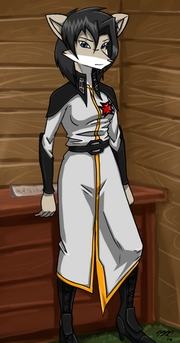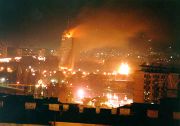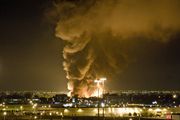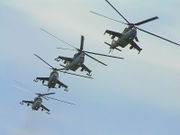2010 Vekaiyun Civil War
The 2010 Vekaiyun Civil War was a three-week long struggle between two factions in Vekaiyu: those who were loyal to the practices of Maxism and Selvala McEva, and those who were loyal to the classic Vekaiyun ideals supported by new Vekaiyun Premier Ikrisia Levinile. This division permeated all levels of Vekaiyun society: even the armed forces was not without division. At war's end, two cities partially lay in ruins. What emerged was a united nation that would be forever changed from the bloodshed of millions.
Contents
Prelude to Battle
Vekaiyu had remained a fairly stable nation since the murder of Max Venavle at the hand of Selvala McEva. However, tensions had been brewing ever since the young former Ler Commodore ascended to power. Maxists were initially furious at the slaying of their former leader, but in a short time Selvala managed to maintain a delicate balance between Maxists and Loyalists. She moved the nation back to a more socialist ideal, which helped the faltering economy, and pardoned all known Maxists. Her fierce vulpine specism and intolerance in foreign policy were echoes from the days of Venavle, and her resistance to forming a sufficient government made her appear more Maxist than Loyalist. With a Maxist in power again, but a Maxist who was apparently not as destructive as Venavle, there was little need for a regime change.
However, Selvala's seeds of doom were already planted. Revelations of her Maxist upbringing disturbed Loyalists, who had grown weary of her policies. Her failures in handling the assassination attempt of Mahanonian ambassador Damon Diehl and her reported sale of weapons of mass destruction to neighboring Listonia brought into question her ability as a leader. Foreign opinion of the Vekaiyun state was one of intolerance of other peoples. In many ways, Maxism was alive and well in Vekaiyu once again.
When Selvala McEva was extradited to the Carbonis Complex for the attempted assassination of Stapen Evesuni and assault upon Kral CommodoreIkrisia Levinile, Levinile assumed the position of Vekaiyun Premier. Little was known about her aside from the fact that she was good at organization and good at maintaining responsibility. Her word was good enough for her orders, and she was humble in her dealings.
Upon arriving back in Eldura after a meeting for the Commonwealth of Independent Nations of The East Pacific (CINTEP), Premier Levinile addressed the nation, stating she would remove the stigma placed upon Vekaiyu and end the intolerance and lukewarm isolation the state had grown to accept. She also promised the removal of Maxists and their destructive ideals, effectively declaring war on the once-powerful faction.
| — Premier Levinile, addressing her officers at a dinner |
The young premier had invited forty of her top commodores and generals to a dinner, but poisoned half of the attendees who were known Maxist sympathizers with strychnine, while the other half was promoted to the positions that had just been freed up. Strychnine was chosen because of the gruesome way in which one dies from it. To Ikrisia, examples were essential to be made.
The War
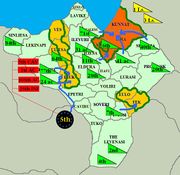
On September 5th, 2010 at approximately 7:30 am VST, three separate explosions - one at a laundromat, one at the Sekavi Trust building, and one at Egelvi Field - took place in Iruk, then Vekaiyu's third-largest city. The three explosions were destructive but merited just under one hundred casualties. That evening, martial law was declared in Iruk, while the Provincial Overseer of Kunnat, Enlil Volesieri, threatened to breakaway from the Vekaiyun nation, saying Kunnat had always supported Maxist ideals. Cities Fek and Ves had also erupted in riots, joining Iruk in the chaos. Three days later, the provinces of Adevi, Kunnat, and Lira had all broken off Vekaiyu to form their own nation, Meyshevyu,in response to Premier Levinile's stubbornness and refusal to bow to their demands. Ikrisia, of course, refused to endorse their claims for independence and set about purging Maxist sympathizers. In those three days, an estimated forty thousand perished from fighting in Iruk.
It was clear a strong plan was needed to quell the destruction and unite the state. Ikrisia drafted a strategy for offense, which she previewed by stating Vekaiyu would never accept fragmentation. Using the skills she gained when she was a Hejul General and Kral Commodore, Ikrisia only used divisions she knew she could count on. Most were headed by relatively new commodores that were promoted at the dinner she held days earlier. Her two most promising commodores, Vil Commodore Vanse Lebivistre and Sipavu Commodore Yamano Nevikalu, were assigned to liberate Iruk. She decided to make it a contest between the two commodores, observing their competitiveness and noting how a combination of Nevikalu's no-nonsense way of thought with Lebivistre's fierceness would make for a strong team. They would also be backed by Alleghenian divisions. The 64th infantry would await the arrival of the 84th infantry to provide a double-encirclement on Ves, tearing through Uliesa. The 2nd and 4th infantry divisions were tied up in the south to protect against any border threats from Packilvania and would remain there to guard against any attacks. The 20th infantry would also remain static to protect Provinsk from any attacks, and the 28th infantry would be stationed in Eldura and had the task of protecting the capital. The 7th would drive to Fek, then encircle it and quell the rioting there. The 6th infantry, however, was encircled due to the battle lines drawn. They would attempt a breakaway with the 11th with the 34th armored corps providing an artillery barrage. In front of them, the 71st infantry and 40th armored corps will attempt a great encirclement and hope to meet at Lira. The 40thwould advance one day later with the hopes of encircling any further enemy divisions and would also meet at Lira. Furthermore, the 1st and 3rd Listonian infantries would ensure no attacks are made on foreign soil.
The operation commenced on the fifth day in order to get organized and positioned. By the seventh day, the battle lines were changing. Slow progress was made on Iruk, while Ves was quickly dealt with, while the 64th infantry was making fast progress on Uliesa. The 6th infantry was easily liberated by the combined efforts of the 11th infantry and 31st armored corps, causing the province of Adevi to quickly bow. Elsewhere, Nilisa, the largest city and provincial capital of Kunnat, had begun rioting against the creation of a separate state from Vekaiyu. Provincial Overseer Enlil Volesieri's dream of forming an independent state were quickly vanishing, and instead attempted to prey on any potential ruthlessness from Ikrisia's tactics.
He did not have to wait long for an example.
The Great Tragedy of Iruk
On September 14th at approximately 11:08 am, the single most deadly minute in Vekaiyun history occurred. Alleghenian helicopters entered the city airspace in the far southeastern quadrant in an attempt to neutralize the Maxist uprising that continued to plague. Upon entering the airspace, the Alleghenian crafts were fired upon by an artillery barrage located in the overrun Kusavil Base, grounds that were seized by Maxists on the first few days of conflict, presumably by Maxist sympathizers working at the base. Alleghenian helicopters returned fire and neutralized the threat. It is believed this retaliation hit a concentration of suvavki, a highly toxic chemical used in some recent polymerization processes that inhibits cellular respiration. Even very small amounts of the chemical can be lethal.
According to Vekaiyun industry standards, suvavki-based polymerization methods are required to be done underground in low pressure environments, as the chemical is very volatile. Such polymerizations occur in level one biological installations, an installation built underground and heavily fortified - even protected from missile attacks. Prior, no accidents had transpired with the chemical.
Within ten minutes of the attack, the area was safe to enter, due in large part to the volatile nature of the chemical. Roughly four million Irukians were killed within the span of a few minutes. To determine blame for such an attack, investigators and scientists were called in to analyze the destruction. It was found roughly two days later that the blame should have been placed on the Maxists, who were attempting to move the chemical above ground in order to load into emptywarheads. Neither Alleghenian helicopters, nor the Vekaiyun divisions present in Iruk, could have known the chemical was above ground.
That did not stop people from attempting to exploit the error. Enlil Volesieri attempted to run a slander campaign against Premier Levinile and President Allen Gordon, but by the time the investigative report had been released, the damage was already done. Volesieri attempted to sue for peace, but was rejected by Levinile. Vigils were held for those who lost their lives in the attack.
Liberation of Kunnat
Acting as a catalyst, the catastrophe helped fuel the Loyalist's cause and rebellion decreased significantly across the nation. Lira fell to the combined efforts of the northern divisions concentrating on the province. Once the province was surrounded, it surrendered to prevent significant damages. Ves, Fek, and Uliesa were all reduced to small pockets of resistance, while Eulo worked internally to solve its seeds of rebellion. Pretty much the only legitimate threats remaining were in Iruk and Kunnat, though Iruk was noticeably weaker and becoming significantly weaker by the day, with many deserting the cause they once believed in.
Vulshain was deeply concerned about how events were turning out in Vekaiyu's civil war. During Vulshain's Monarchical Revolution, Vekaiyu came to Vulshain's aid in overthrowing the military fascist Republican Regime of Merrill Rivers and restoring the Vulshainian Monarchy. Thus, Vulshain offered to assist Vekaiyu against the Maxists, just as Vekaiyu had assisted Vulshain against Merrill Rivers. Ikrisia accepted the Vulshainians' offer to restore order to the province, understanding that their soldiers' liberating the province would correlate to less Vekaiyun soldier deaths. The Southern Fleet of the Vulshainian Confederate Navy formed a blockade around Nilisa while also attacking the coastal defenses protecting the city. Many civilians were killed in the first days of the siege as the Vulshainians were unable to prevent hitting civilian areas.
After the defenses were destroyed, the Confederates launched a ground assault assisted by aerial support from Hind gunships. Meanwhile, Vulshainian T-90 tanks of the 48th and 20th Armored Corps smashed enemy armored units. Another group attempted to assume control. Led by General Drew Brock Alvarado, the Revolutionary Republican Armed Movement (RRAM) entered the scene in an attempt to control the province. After much fighting, all looked to be lost for both the Maxists and the RRAM. Provincial Overseer Volesieri was assassinated by Alleghenian special forces commandos, later covered up as a suicide attempt. While this helped to force many Maxists to surrender to the advancing Vulshainian Confederates, the opposite occurred for the RRAM, as they attempted to fill in the void left by the defeated Maxists. The RRAM began to spark riots and widespread bombings as they tried to take over the city. This enraged the Vulshainians who vowed to wipe the RRAM out, and they began to systematically do just that. The Vulshainians restored order by the beginning of October 2010, capturing General Drew Brock Alvarado.
Aftermath
As the civil war draw to a close, the Vekaiyun government worked to restore the areas most affected by the war. As a whole, the provinces ofAdevi, Eulo, Fek, Iruk, Kunnat, Lira, Uliesa, and Ves were the only provinces to require involvement with the Vekaiyun armed forces in orderto restore order. The war lasted roughly one month, and no doubt cost the nation of Vekaiyu billions of Veskonos, especially in the cities if Nilisa and Iruk. To compensate, the governments of Free Pacific States and Veerilion donated large cash sums and foodstuffs, but the Vekaiyun economy was hit hard during and shortly after the war. Vulshain also donated, but they went further and sent doctors as well as foodstuffs, clothing, toys, medical supplies, and other necessities.
It reached stability at the end of October and has steadily risen(as of late December 2010), but this could be a false assurance. It is worried this could follow a recession, but it is difficult to tell when the state makes a full recovery.
The city of Iruk, hardest hit in the civil war, began a rebuilding campaign. The city is expected to make a structural recovery within one year, but it is clear the amount of lives lost may be irrecoverable. The estimated body total is now around 2.9 million, down from the previous estimates, but still substantial at just over 20% of the city's original population. Memorials are currently in discussion, with a great mausoleum apparently leading the way. Alleghenian soldiers work jointly with Vekaiyun soldiers to provide order and medical assistance. As the city recovers, an influx of new jobs are expected to open up. If there is one benefit that comes from this, the unemployment rate of the province and perhaps the nation itself could dip. Only time will tell the fate of Vekaiyu's former third largest city.
| Vekaiyu | ||
|---|---|---|
| Main article: Vekaiyu | ||
| Important Topics: Culture ♦ Unonian ♦ Vayan Catholicism ♦ Veskono ♦ Vulpine ♦ Armed Forces ♦ Military Ranks and Uniforms | ||
| Government: Kivreskov ♦ Premier ♦ Ikrisia Levinile ♦ Political Parties ♦ Foreign Officers | ||
| History: Ancient Vekaiyu ♦ The Time of Troubles ♦ Era of Good Feelings ♦ Trade Leagues ♦ Expansionist Vekaiyu ♦ Partitions of Vekaiyu ♦ Imperial Vekaiyu ♦ Vekaiyu Under Max Venavle ♦ Vekaiyu Under Selvala McEva ♦ 2010 Vekaiyun Civil War | ||
| Important Figures (Past and Present): Ikrisia Levinile ♦ Leina Kivelevov ♦ Max Venavle ♦ Selvala McEva ♦ St. Aiya ♦ Todd Leyuski | ||
| Sports: Sports in Vekaiyu ♦ Olympic Council ♦ Sport Uniforms ♦ Fifth Summer Olympics ♦ Sixth Winter Olympics ♦ Seventh Summer Olympics ♦ Eighth Summer Olympics | ||

